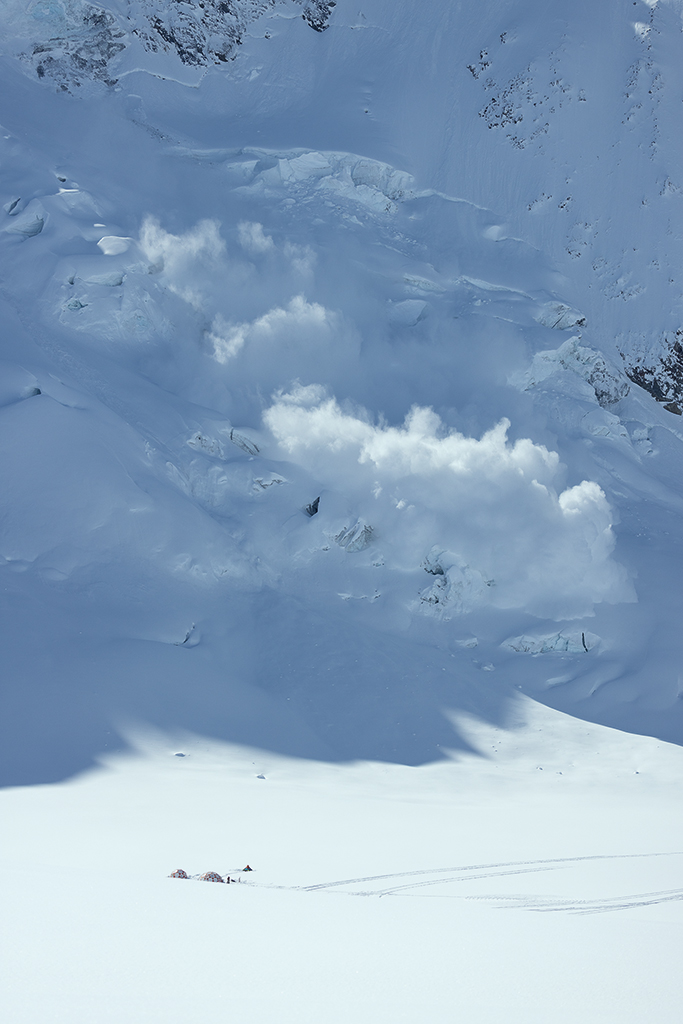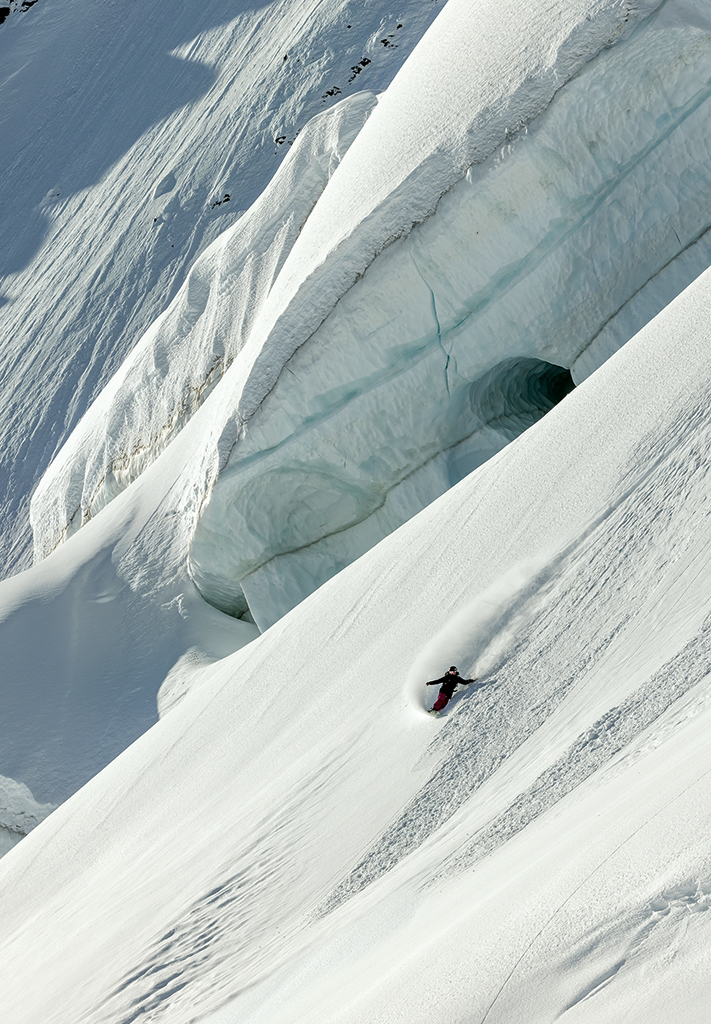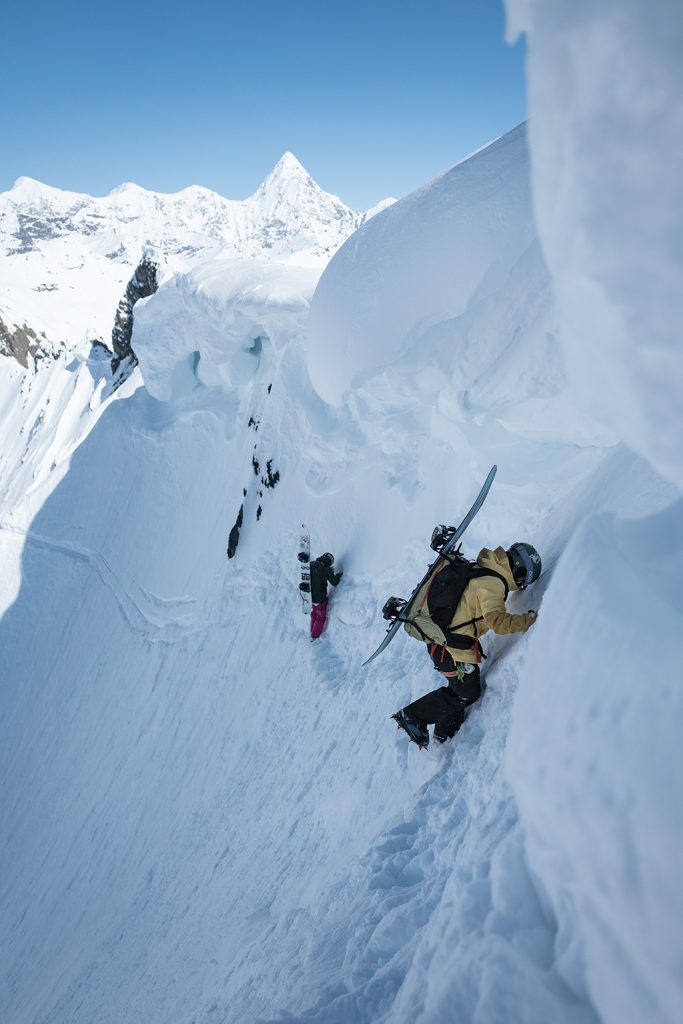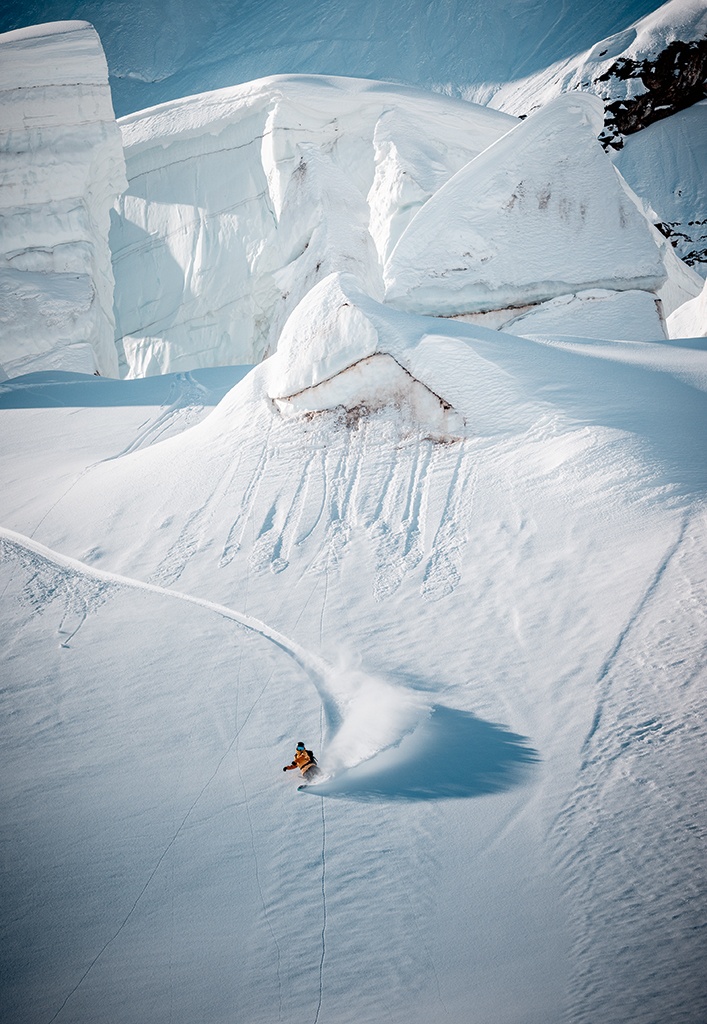Adventure
Some Kind of Flow in Alaska
Lessons Shared on Nautilus
Scroll Down to Read
First published in Volume 21, Issue 2 of The Snowboarder’s Journal
This feature story is supported by Arc’teryx
Flying above the Alaska Range in search of a spot to glacier camp for three weeks, it was clear that our options were limited by low tide conditions—the kind where you can’t really land a plane. Open crevasses and wind-scoured, rocky peaks marked the entire landscape. Nothing like normal Alaska. We kept pointing out spots that had potential, but inside they looked more like a toothy grin. Yet after a solid tour of the range, we found one spot that looked promising: Nautilus, an amphitheater of lines perched above the Dall Glacier.
Elena Hight finding flow on her way back to camp in the Alaska Range.
Photo: Aaron Blatt
Nautilus was a shot in the dark, Google Earth pin scoped by Travis Rice during his filming of “The Fourth Phase” [2016]. Zones like this can be kept close to preserve private Idahos, but Travis was kind to share it. As we flew through its steep pearly gates and above its glaciated valley, the source of its name became clear: a shell-shaped basin that swirled into a hidden plethora of lines on every aspect. It was the only spot we saw that had enough potential and coverage to hike and shred; an anomaly that had trapped just enough magic.
As a crescendo for a winter spent camping from Baker to Tahoe to Whistler, we’d planned the perfect picnic: dialed crew, tons of food, guide, shelter, filmers, photographers, ropes, axes and splitboards. Leslie Hittmeier, Jeff Keenan, Aaron Blatt and Rafe Robinson on cameras, Shane Treat and his dog, Ama, guiding alongside Ben Hoiness, and Justin Sweeney as chef. We were laced for an epic. We just needed the mountains to cooperate.
The crew scopes for camp aboard the Talkeetna Air Taxi.
Photo: Michelle Parker
With us was a special tent. We’d assembled it using 137 unrepairable jackets. After eventful lives in the mountains, winter jackets often find their end in a stagnant basement closet or worse, in the trash, ripped beyond repair. But the material doesn’t end; in some form, it always remains. Our idea was to see what’s possible when it comes to re-use by repurposing these fabrics that have carried their wearers through countless adventures, good and bad. Timestamps and smells of memories and moments of past lives marked the tent’s walls, giving it serious soul. In appreciation of lives well lived, it only felt right to take this prismatic creation back to where it started for another stab at the full experience of life outside.
The tent would get the prized position in camp, closest to the looming walls of the amphitheater, below a massive hanging glacier. We’d camped in it throughout the winter, partied in it, created and left our marks on it as we went. It weathered rain and snow and wind but remained strong. Still, nothing puts the gear, and the people using it, to the test like Alaskan glaciers. So, we’d embarked on a pinnacle foot-powered trip to cap off a full season of filming for Arc’teryx’s film, CONTINUUM.
“Camp and the daily dose of the mountains’ reminders.”—Robin Van Gyn
Photo: Aaron Blatt
A beautiful hike up, but a harsh ride down. Robin Van Gyn and Elena Hight nearing the top of their first run of the trip.
Photo: Aaron Blatt
In the process of building camp, the snow seemed better than we had previously thought. With tons of sun in the forecast and one little reset on the way, we optimistically took our time building the perfect little village. One of my favorite things about glacier camping is the setup process—seeing how efficient you can make your tent scene, how dry you can keep your gear, how organized your socks and hats can be, creating a hygiene corner, seeing how much power you can get from your solar rig—it’s a game and we all compete. Nothing lights me up more than feeling like I could stay for months on end in the wild. Everyone’s snow yard was sculpted differently, and it was a fun neighborhood stroll checking out the landscaping. Our tents were neatly spaced on either side of the main street, slightly offset from our neighbors across the way. The road led to the cook tent and up toward our jacket tent, which provided a functional hang and scope zone. Justin and Elena constructed wind walls, while Jeff, Shane and I had gear storage and drying areas. Blatt and Michelle, alongside Leslie and Ben, had main house and ADU (accessory dwelling unit) style lots. Then there was Rafe with a bench specifically made for our resident squirrel Chippy (a literal lawn ornament) and our volleyball, Wilson.
Robin humbled by the sheer vastness of Alaska.
Photo: Michelle Parker
We started slow, knowing there was time, scoping ascents and descents to give ourselves extensive possibilities. When the sun is out it’s hard not to jump on the first thing you see, but easing into it is always a good progression so you are ready for action when conditions fall into place. It was time to get closer to Nautilus—to check the dipstick before starting the real journey.
Robin transitions from sharp edging to smooth sliding. No way out but down.
Photo: Leslie Hittmeier
In creating a mental terrain map, we learn a lot about different perspectives and past experiences. Sometimes we see the same things, but sometimes you pretend to know what “hump” your riding partner is talking about when describing a line. We all note the light, and the lines we think we see—it takes creative collaboration to reach an overall plan. When you don’t have technology to rely upon for access and avalanche reports, you learn to take bits of strength from each person to create a cohesive and powerful whole; you communicate like your life depends on it, because it does. It’s fun. When everyone’s voice is accounted for it becomes a true collaboration of cumulative time in the mountains, each person drawing upon their own knowledge base. Finding out who is best at what and leaning into that creates a perfect landscape to acquire more of the skills we individually bring to the table.
Yet our first line brought us down from our sunny outlook. We climbed for an hour and a half in firm and variable snow. Sometimes the ascent can give you a good idea what it will be like on the way down. On the other hand, we usually hike up protected runnels of frozen sluff that are adjacent to the spines themselves, so there is always hope that the differing aspect and terrain features will hold better snow. This time, it didn’t. What looked creamy was more of a stay-on-your-edge-and-ride-with-your-ice-axe-in-hand scenario. A learning moment: if the hike straight up the line seems sus, think about what the ride down might be like before going too far. We laughed it off and relived the hairball moments, then pivoted focus to the main objective right above camp: the longest and best-looking lines in the zone.
Home on the glacier.
Photo: Leslie Hittmeier
Robin Van Gyn, Elena Hight and Michelle Parker tend to some down day chores.
Photo: Leslie Hittmeier
As the days started to stack, we found a rhythm of breakfast meetings, nighttime games, and a hell of a lot of laughing. Rafe’s antics with Chippy and constant ridiculousness kept the mood light. We learned who would be ready first (Elena), who always has a lighter (Rafe), and who not to speak to before coffee (me)—it was fast-track familiarization. On top of learning each other’s personal nuances, the inherent down time and off-grid nature of glacier camping leads to hearing the best stories from everyone’s lives on the road—an unfolding of life that is only shared when you have the nothingness of time for idle chit-chat. It’s real time with real people, and I loved listening to everyone’s best and most exhilarating mountain experiences, alongside the “almost died” stories that teach good lessons. It is in these in-between moments that you build trust and become tighter as a crew. But as nice as the downtime may be, we go to the mountains to ride.
“The Abominable Snowman finally getting his Dwell-worthy front entrance in print. Elena Hight with a foreground appearance.” – Robin Van Gyn
Photo: Aaron Blatt
By day four, with only one line ridden, the weather seemed stable: clear skies and no wind. At 10 a.m. we started the steep ascent up the runnel between two lines on the prominent wall above camp we called Nautilus proper. A steep, spine-riddled face standing around 1,000 vertical feet, we were limited by a lack of exits on this low snow year—most of the spines closed out into rocks at the bottom. Dodging sluffs and sweating profusely, we booted up with all tools in play: two ice axes, harness with crevasse kit, rope, crampons, a ton of ski straps, poles, and of course the shred rod. The silence of the up-track gave a mix of pure focus, self-talk and reflection upon life in general. The whys lingered, but the answers were, and are, never truly clear. Regardless, we fell into a meditation, one behind the other in the middle of nowhere, struggling for fun. The snow was, as we expected, variable—a mix of wind effect, ice and shallow powder gave us little read on what the actual riding would be like.
Sometimes you can learn so much about a person just by the way they breathe under pressure. I noticed Elena’s strong and forceful exhale coupled with a squat, and Michelle’s low and slow breath then pole tap before dropping in. When the risk is higher, all cards are face up on the table. We get to know each other pretty well in the throes of exposure.
Elena Hight and Robin Van Gyn flexing their tool kit.
Photo: Michelle Parker
Robin Van Gyn and Elena Hight traversing to a drop in—a move that Robin calls “Quite possibly the spiciest moment of the entire trip.”
Photo: Michelle Parker
Cresting the top, the surrounding ocean of peaks let us feel minuscule. The questions melted away, even just for a moment. Michelle went first and radioed back up with a so-so review: not only variable snow, but also fast-running sluff. With less edges on our snowboards, Elena and I were challenged to pick up speed between ice and freight train sluff. It took deep focus to stay controlled and in rhythm back to a flat glacial coast to the tent.
One-hundred-and-thirty-seven high fives back at camp, a place to recount the descent moment by moment, a decompression to set us up for another climb. From topping out and being overwhelmed by beauty, to being absolutely gripped traversing on foot under a massive cornice to our lines, we relived the full spectrum of feelings from the morning. With exhausting and challenging learning moments behind us, it was another massive Alaskan line for the mountain logbook, and we were finding some kind of flow.
“137 voices, silent under the Alaskan sky.”
—Robin Van Gyn
Photo: Aaron Blatt
After a four-inch reset overnight, we were back on the skin track and into the bootpack for round two on Nautilus proper. Despite the new snow, conditions hadn’t changed much: steep, variable, unpredictable and fast-moving sluff that was hard to manage. Conditions dictated we not go too fast, so our sluff was beside, around, ahead of us, always a threat to take you for a ride you don’t want to go on. Not perfect, but exciting nonetheless. Riding on exhilaration and in the flow, we wanted one more. There were some spicier lines to looker’s right that appeared to go. With confidence built from two successful lines, we started to make a plan. During our discussion, we all felt the warmth on our backs—a temperature shift.
Just past the skin track and into the first transition with crampons on, the mountain raised its voice. Shane and I had to traverse through a small pocket of exposure to get on the face—maybe 10 steps. Shane went first and made it through clean. As I followed, three steps in, snow began to pour like champagne over a roll 30 feet above me. It might have only been a five-foot-wide river of snow, but the weight was crushing. I dug in, put my head down, and held on as it passed over me. Reaching Shane 30 seconds later, a larger sluff followed through in the same spot. It could have been enough to sweep us to the bottom.
“We’re done,” I said over the radio. Elena and Michelle were wallowing up a spine, making little progress. They agreed. Everyone agreed. With all voices from our tent, all voices from our mountain past, all voices from media, and all voices of the mountain yelling “get off,” we did just that.
One-hundred-and-thirty-seven humbling hugs and one-hundred-and-thirty-seven “glad you’re OKs” met us back at the tent. From the safety of camp, we watched the mountains come down around us.
Between towers of ice, Robin Van Gyn finds a hack-worthy pocket of fresh snow.
Photo: Aaron Blatt












